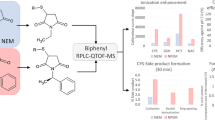Abstract
A fluorescent adduct was formed between 2,4′-dichloro-l-(naphthyl-4-ethoxy)-s-triazine (EDTN) and reduced glutathione in a reaction at 37 °C and pH 9.2. This reaction was used as the basis of an assay for reduced glutathione. The fluorescence was examined at an excitation wavelength of 319 nm and an emission wavelength of 425 nm after extraction of residual unreacted EDTN with methylene dichloride and subsequent dilution of the aqueous phase with ethanol containing 0.01 percent Triton X-100. The reaction rate was low at pH 7 but was accelerated by addition of preparations containing the enzyme glutathione-S-transferase. The adduct gave a discrete peak using isocratic elution with HPLC on a Nova-pak C18 3 μm reverse phase column and a solvent system of methanol: 0.1 M phosphate buffer pH 6.3 (40∶60). An analytical concentration range of 24 to 240 μM reduced glutathione was obtained with an ultraviolet detection system but the concentration range was 7.5 to 75 μM when a fluorescence detection system was used. Adducts of other mercapturic acid pathway thiol compounds were not formed at 37 °C under the conditions used and hence did not interfere in the assay. They were formed by heating EDTN and the respective thiol compound at 60 °C for 30 min and they clearly separated from the reduced glutathione compound on HPLC analysis. A strong reaction was observed with digitonin while solutions of tyrosine, at 10 mM concentration, also reacted but these reactants are unlikely to interfere with reduced glutathione analysis in biological systems. When adduct formation was used to estimate reduced glutathione concentrations in some mammalian and plant tissues the reaction using 2,4′-dichloro-l-(naphthyl-4-ethoxy)-s-triazine and HPLC separation gave the same results as ano-phthaldialdehyde assay for liver and muscle but the HPLC method gave slightly lower values for other mammalian and plant tissues. The differences were attributed to other material in the tissue extracts which was fluorescing at the same wavelengths as the reduced glutathione adduct.
Similar content being viewed by others
References
A. Meister, M. E. Anderson,Ann. Rev. Biochem. 1983,52, 711.
V. H. Cohn, J. Lyle,Anal. Biochem. 1966,14, 434.
R. C. Fahey, G. L. Newton, R. Dorian, E. M. Kosower,Anal. Biochem. 1981,111, 357.
L. Mokrasch, E. J. Teschke,Anal. Biochem. 1984,140, 506.
H. Nakamura, Z. Tamura,Z. Anal. Chem. 1981,53, 2190.
H. Nakamura, Z. Tamura,Z. Anal. Chem. 1982,54, 1951.
G. L. Newton, R. Dorian, R. C. Fahey,Anal. Biochem. 1981,114, 383.
R. C. Scaduto,Anal. Biochem. 1988,174, 265.
R. Chayen, S. Gould, A. Harrell, C. V. Steed,Anal. Biochem. 1977,39, 533.
S.-M. Wu, S.-H. Chen, H.-L. Wu,Anal. Chim. Acta. 1992,268, 255.
A. G. Clark, M. Letoa, S. T. Wong,Life Sci. 1977,20, 141.
B. Mannervik, H. Jennson,J. Biol. Chem. 1982,257, 9909.
G. L. Ellman,Arch. Biochem. Biophys. 1959,59, 70.
W. H. Habig, M. J. Pabst, W. B. Jakoby,J. Biol. Chem. 1973,249, 7130.
J. Lakowicz,Principles of Fluorescence Spectroscopy. Plenum Press, New York, 1983, pp. 187–216
J. C. Roberts and D. J. Francetic,Anal. Biochem. 1993,211, 183.
D. Blakeslee,J. Immunol. Methods 1977,17, 361.
Author information
Authors and Affiliations
Rights and permissions
About this article
Cite this article
Chen, X.P., Cross, R.F., Clark, A.G. et al. Analysis of reduced glutathione using a reaction with 2,4′-dichloro-1-(naphthyl-4-ethoxy)-s-triazine (EDTN). Mikrochim Acta 130, 225–231 (1999). https://doi.org/10.1007/BF01242910
Received:
Revised:
Issue Date:
DOI: https://doi.org/10.1007/BF01242910




